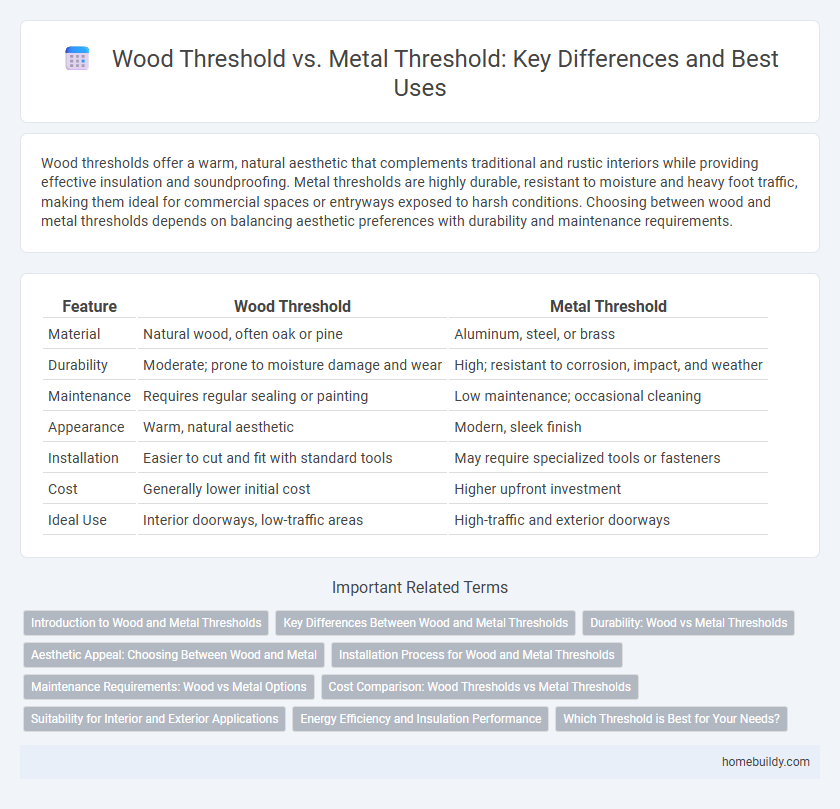Wood thresholds offer a warm, natural aesthetic that complements traditional and rustic interiors while providing effective insulation and soundproofing. Metal thresholds are highly durable, resistant to moisture and heavy foot traffic, making them ideal for commercial spaces or entryways exposed to harsh conditions. Choosing between wood and metal thresholds depends on balancing aesthetic preferences with durability and maintenance requirements.
Table of Comparison
| Feature | Wood Threshold | Metal Threshold |
|---|---|---|
| Material | Natural wood, often oak or pine | Aluminum, steel, or brass |
| Durability | Moderate; prone to moisture damage and wear | High; resistant to corrosion, impact, and weather |
| Maintenance | Requires regular sealing or painting | Low maintenance; occasional cleaning |
| Appearance | Warm, natural aesthetic | Modern, sleek finish |
| Installation | Easier to cut and fit with standard tools | May require specialized tools or fasteners |
| Cost | Generally lower initial cost | Higher upfront investment |
| Ideal Use | Interior doorways, low-traffic areas | High-traffic and exterior doorways |
Introduction to Wood and Metal Thresholds
Wood thresholds provide a natural aesthetic with excellent insulation properties, making them ideal for interior doorways where warmth and style are priorities. Metal thresholds, commonly made of aluminum or steel, offer superior durability and resistance to weather elements, often used in exterior doorways or high-traffic areas. Both options serve as practical solutions for sealing gaps and preventing drafts, with material choice depending on environmental exposure and design preferences.
Key Differences Between Wood and Metal Thresholds
Wood thresholds offer natural insulation and aesthetic warmth, making them ideal for traditional or rustic interiors, while metal thresholds provide superior durability and resistance to moisture and heavy foot traffic. Metal thresholds often require less maintenance and are typically more resistant to warping, unlike wood, which may expand or contract with temperature and humidity changes. Price and installation complexity also vary, with wood generally being easier to customize but less resilient compared to the strong, long-lasting qualities of metal thresholds.
Durability: Wood vs Metal Thresholds
Metal thresholds offer superior durability compared to wood thresholds due to their resistance to wear, moisture, and temperature fluctuations. Wood thresholds are prone to warping, rotting, and insect damage, especially in high-traffic or moist environments. Choosing metal thresholds ensures longer lifespan and reduced maintenance costs in both residential and commercial applications.
Aesthetic Appeal: Choosing Between Wood and Metal
Wood thresholds offer a warm, natural aesthetic that complements traditional and rustic interior designs, enhancing the visual appeal with rich textures and customizable finishes. Metal thresholds provide a sleek, modern look characterized by clean lines and durability, ideal for contemporary spaces requiring a minimalist design approach. Selecting between wood and metal thresholds depends on the overall style preference and the desired balance between elegance and industrial chic.
Installation Process for Wood and Metal Thresholds
Installing a wood threshold involves cutting the piece to fit the doorway, securing it with finishing nails or screws, and sealing gaps with caulk to prevent drafts and moisture. Metal thresholds require precise measurements followed by drilling holes for screws, ensuring anchoring to concrete or subfloor surfaces with appropriate fasteners for durability. Both processes demand surface preparation but metal thresholds often necessitate specialized tools like a drill with masonry bits for installation on harder substrates.
Maintenance Requirements: Wood vs Metal Options
Wood thresholds require regular sealing or varnishing to prevent warping, rot, and insect damage, while metal thresholds demand minimal upkeep, typically only needing occasional cleaning to avoid corrosion. Moisture exposure accelerates deterioration in wood, making it less ideal for high-humidity areas compared to metal, which withstands environmental stress better. Metal thresholds commonly feature rust-resistant coatings, enhancing durability and reducing long-term maintenance costs compared to wood alternatives.
Cost Comparison: Wood Thresholds vs Metal Thresholds
Wood thresholds generally cost less upfront compared to metal thresholds, making them a budget-friendly option for homeowners seeking affordability. Metal thresholds, often made from aluminum or stainless steel, have a higher initial price but offer greater durability and lower long-term maintenance costs. Selecting between wood and metal thresholds depends on balancing initial investment with longevity and wear resistance requirements.
Suitability for Interior and Exterior Applications
Wood thresholds offer natural insulation and aesthetic appeal, making them ideal for interior applications where warmth and style are priorities. Metal thresholds provide superior durability and weather resistance, better suited for exterior entrances exposed to frequent foot traffic and harsh environmental conditions. Selecting between wood and metal thresholds depends on balancing interior comfort with exterior resilience requirements.
Energy Efficiency and Insulation Performance
Wood thresholds offer superior insulation performance due to their natural thermal resistance, reducing heat transfer and enhancing energy efficiency in both heating and cooling systems. Metal thresholds, while more durable, often conduct heat and cold, potentially increasing energy loss unless equipped with thermal breaks or insulated cores. Choosing wood thresholds can contribute to lower energy bills and improved indoor comfort by minimizing drafts and thermal bridging at doorways.
Which Threshold is Best for Your Needs?
Wood thresholds offer natural warmth and aesthetic appeal, making them ideal for residential interiors where style and comfort matter. Metal thresholds provide superior durability and resistance to heavy foot traffic, perfect for commercial spaces or high-moisture areas. Choosing the best threshold depends on factors like location, frequency of use, and environmental conditions to ensure longevity and functionality.
Wood Threshold vs Metal Threshold Infographic

 homebuildy.com
homebuildy.com